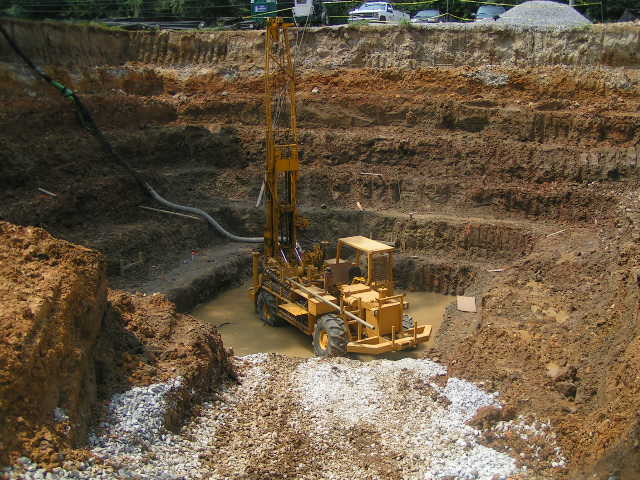Experienced Geotechnical Geologist for In-Depth Ground Investigations
Wiki Article
Just How Consulting Engineers Enhance Geotechnical Design Projects: Insights Into Their Expertise, Methodologies, and Collaborative Approaches
Consulting designers are critical in enhancing geotechnical engineering tasks, using their specialized expertise to browse the complexities of subsurface problems. Their joint methods foster interaction amongst diverse job stakeholders, inevitably forming the project's trajectory.Duty of Consulting Engineers
The proficiency of getting in touch with engineers in geotechnical design is basic to the effective execution of building projects. These specialists play an essential duty in evaluating dirt and rock properties, which are important variables affecting style and building decisions. By conducting comprehensive site examinations, getting in touch with engineers collect crucial information that informs the style process, making sure tasks are constructed on steady and suitable ground.Consulting engineers also provide very useful understandings into risk monitoring (geotechnical geologist). They determine possible geotechnical risks, such as landslides, soil liquefaction, and settlement problems, making it possible for stakeholders to execute reliable mitigation strategies. Their proficiency help in enhancing foundation styles, which can result in considerable expense financial savings and boosted security
In addition, getting in touch with engineers serve as a vital web link in between task proprietors, designers, and specialists. Their ability to translate intricate geotechnical data into actionable referrals fosters cooperation and assists in notified decision-making throughout the project lifecycle. This multidisciplinary strategy not only improves job performance yet also ensures conformity with regulative requirements and finest techniques.
Secret Methods in Geotechnical Design

One primary method is website examination, which involves carrying out area tests and lab evaluations to gather information on subsurface conditions. Methods such as Requirement Penetration Testing (SPT) and Cone Penetration Screening (CPT) are commonly used to review dirt stratigraphy and toughness. Additionally, geophysical methods, consisting of seismic and electrical resistivity surveys, supply non-invasive ways to analyze subsurface qualities.
One more vital technique is mathematical modeling, which allows designers to replicate different situations and predict how soil-structure interactions will certainly act under various loading conditions. Finite Element Evaluation (FEA) is an usual strategy used in this context.
Additionally, the style of foundations, keeping structures, and earthworks relies greatly on these techniques - geotechnical geologist. By integrating sophisticated analytical devices with area information, speaking with designers can develop tailored services that deal with specific task difficulties, eventually adding to the security and security of construction projects
Relevance of Dirt Analysis
Dirt analysis functions as a fundamental component in geotechnical design, providing crucial insights right into the physical and chemical buildings of soil essential for effective building preparation. Comprehending dirt characteristics is critical for identifying its load-bearing ability, drain actions, and capacity for negotiation or instability. Detailed soil examinations, including tasting and research laboratory testing, assistance identify specifications such as dirt type, dampness content, thickness, and shear strength.
These analyses educate the selection of suitable building and construction techniques and materials, eventually affecting project security and long life. For instance, natural dirts may require different structure layouts compared to granular soils, requiring customized design remedies. Soil analysis help in recognizing impurities that might posture threats to human health or the environment, enabling for the advancement of mitigation approaches.
Integrating soil analysis right into the onset of job development helps to minimize unpredicted obstacles, making hop over to here sure that designers can anticipate and address possible problems before they escalate. By developing a detailed understanding of the site conditions, getting in touch with designers can enhance design performance and minimize costs, therefore improving the overall success of geotechnical design jobs.
Collaborative Strategies in Jobs
Successful geotechnical tasks commonly hinge on collaborative strategies that combine diverse knowledge from various techniques. Efficient collaboration amongst seeking advice from engineers, rock hounds, environmental scientists, and building and construction experts is critical for attending to complex obstacles and optimizing task outcomes. By leveraging the one-of-a-kind skills and understanding of each group member, tasks can gain from an alternative understanding of the website conditions, regulative needs, and engineering restrictions.Normal communication and interdisciplinary conferences facilitate the sharing of insights and promote a society of teamwork. These collaborative initiatives make it possible for the identification of prospective threats early in the project lifecycle, enabling for prompt reduction strategies. Furthermore, including responses from stakeholders, including local neighborhoods and governing firms, ensures that all point of views are thought about, boosting task approval and compliance.
Additionally, the combination of innovative innovations, such as Geographic Information Systems (GIS) and Building Information Modeling (BIM), additional improves partnership. These tools enable the real-time sharing of information and visualization of geotechnical problems, advertising Visit This Link notified decision-making. Eventually, a collective technique not only enhances job execution but also lays the foundation for cutting-edge remedies to intricate geotechnical design difficulties.
Effect on Job Outcomes

Consulting engineers utilize sophisticated methodologies such as threat assessment and anticipating modeling, which enhance the precision of job projections. Their ability to incorporate innovative innovations, like geotechnical instrumentation and data analytics, further improves the layout and construction processes. Because of this, projects experience enhanced performance, reduced expenses, and lessened hold-ups.
Furthermore, promoting reliable interaction and collaboration among employee enhances analytical abilities. When obstacles arise, an unified front permits speedy recognition of solutions, avoiding prospective troubles. Inevitably, the collaborative efforts of speaking with designers contribute to higher quality end results, making certain that projects satisfy both regulatory requirements and customer expectations.
Verdict

Report this wiki page